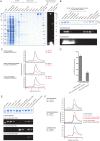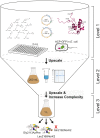Site-Specific Labelling of Multidomain Proteins by Amber Codon Suppression
- PMID: 30291265
- PMCID: PMC6173736
- DOI: 10.1038/s41598-018-33115-5
Site-Specific Labelling of Multidomain Proteins by Amber Codon Suppression
Abstract
The access to information on the dynamic behaviour of large proteins is usually hindered as spectroscopic methods require the site-specific attachment of biophysical probes. A powerful emerging tool to tackle this issue is amber codon suppression. Till date, its application on large and complex multidomain proteins of MDa size has not been reported. Herein, we systematically investigate the feasibility to introduce different non-canonical amino acids into a 540 kDa homodimeric fatty acid synthase type I by genetic code expansion with subsequent fluorescent labelling. Our approach relies on a microplate-based reporter assay of low complexity using a GFP fusion protein to quickly screen for sufficient suppression conditions. Once identified, these findings were successfully utilized to upscale both the expression scale and the protein size to full-length constructs. These fluorescently labelled samples of fatty acid synthase were subjected to initial biophysical experiments, including HPLC analysis, activity assays and fluorescence spectroscopy. Successful introduction of such probes into a molecular machine such as fatty acid synthases may pave the way to understand the conformational variability, which is a primary intrinsic property required for efficient interplay of all catalytic functionalities, and to engineer them.
Conflict of interest statement
The authors declare no competing interests.
Figures







Similar articles
-
In-frame amber stop codon replacement mutagenesis for the directed evolution of proteins containing non-canonical amino acids: identification of residues open to bio-orthogonal modification.PLoS One. 2015 May 26;10(5):e0127504. doi: 10.1371/journal.pone.0127504. eCollection 2015. PLoS One. 2015. PMID: 26011713 Free PMC article.
-
Expanding the Zebrafish Genetic Code through Site-Specific Introduction of Azido-lysine, Bicyclononyne-lysine, and Diazirine-lysine.Int J Mol Sci. 2019 May 26;20(10):2577. doi: 10.3390/ijms20102577. Int J Mol Sci. 2019. PMID: 31130675 Free PMC article.
-
Expanding the genetic code of Mus musculus.Nat Commun. 2017 Feb 21;8:14568. doi: 10.1038/ncomms14568. Nat Commun. 2017. PMID: 28220771 Free PMC article.
-
Context effects of genetic code expansion by stop codon suppression.Curr Opin Chem Biol. 2018 Oct;46:146-155. doi: 10.1016/j.cbpa.2018.07.012. Epub 2018 Jul 29. Curr Opin Chem Biol. 2018. PMID: 30064064 Review.
-
Fatty Acid Biosynthesis: Chain-Length Regulation and Control.Chembiochem. 2019 Sep 16;20(18):2298-2321. doi: 10.1002/cbic.201800809. Epub 2019 Jun 27. Chembiochem. 2019. PMID: 30908841 Review.
Cited by
-
Efficient Amber Suppression via Ribosomal Skipping for In Situ Synthesis of Photoconditional Nanobodies.ACS Synth Biol. 2022 Apr 15;11(4):1466-1476. doi: 10.1021/acssynbio.1c00471. Epub 2022 Jan 21. ACS Synth Biol. 2022. PMID: 35060375 Free PMC article.
-
HIV-1 Capsid Uncoating Is a Multistep Process That Proceeds through Defect Formation Followed by Disassembly of the Capsid Lattice.ACS Nano. 2024 Jan 30;18(4):2928-2947. doi: 10.1021/acsnano.3c07678. Epub 2024 Jan 19. ACS Nano. 2024. PMID: 38241476 Free PMC article.
-
Synthetic Organelles for Multiple mRNA Selective Genetic Code Expansions in Eukaryotes.Methods Mol Biol. 2023;2563:341-369. doi: 10.1007/978-1-0716-2663-4_17. Methods Mol Biol. 2023. PMID: 36227482
-
Dodecin as carrier protein for immunizations and bioengineering applications.Sci Rep. 2020 Aug 6;10(1):13297. doi: 10.1038/s41598-020-69990-0. Sci Rep. 2020. PMID: 32764653 Free PMC article.
-
The architectures of iterative type I PKS and FAS.Nat Prod Rep. 2018 Oct 17;35(10):1046-1069. doi: 10.1039/c8np00039e. Nat Prod Rep. 2018. PMID: 30137093 Free PMC article. Review.
References
-
- Chang S-I, Hammes GG. Structure and Mechanism of Action of a Multifunctional Enzyme: Fatty Acid Synthase. Acc. Chem. Res. 1990;23:363–369. doi: 10.1021/ar00179a003. - DOI
Publication types
MeSH terms
Substances
LinkOut - more resources
Full Text Sources
Other Literature Sources
Research Materials

